PREVIOUS
RTE Act 2009
October 11 , 2019
2288 days
29243
0
- Education in the Indian constitution is a concurrent issue and both centre and states can legislate on the issue.
- In a 1992 Supreme Court Judgment (Mohini Jain Vs State of Karnataka), the SC held that the right to education was a fundamental right included in right to life guaranteed under Article 21 of the Indian Constitution.
- The Constitution (Eighty-sixth Amendment) Act, 2002 inserted Article 21-A in the Constitution of India to provide free and compulsory education of all children from socially and economically backward classes in the age group of six to fourteen years as a Fundamental Right in such a manner.
- Thus, this amendment made the directive principle (Article 45) into a fundamental right.
- The Right of Children to Free and Compulsory Education (RTE) Act, is an Act of the Parliament of India enacted on 4 August 2009, which represents the Article 21-A.
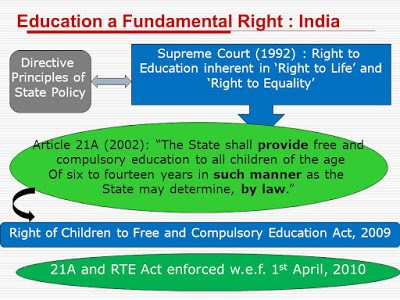
- Under this Act, every child has a right to full time elementary (Primary school + Middle School) education of satisfactory and equitable quality in a formal school which satisfies certain essential norms and standards.
- Running a school without recognition will also attract penal action.
- This Act lays down the duties of the appropriate Government and the local authority to ensure that good quality elementary education conforming to norms and standards is provided, curriculum and courses of study are prescribed in a timely manner, and teachers are trained.
- Article 21-A and the RTE Act came into effect on 1 April 2010 in the whole of India except the state of Jammu and Kashmir.
- It now came into Act in Kashmir after it turned a union territory of India in 2019.
- The title of the RTE Act incorporates the words ‘free and compulsory’.
- Free education means that no child, shall be liable to pay any kind of fee or charges or expenses which may prevent him or her from pursuing and completing elementary education.
- Compulsory education casts an obligation on the appropriate Government and local authorities to provide and ensure admission, attendance and completion of elementary education by all children in the 6-14 age group.
- With this, India has moved forward to a rights-based framework that casts a legal obligation on the Central and State Governments to implement this fundamental child right as enshrined in the Article 21A of the Constitution, in accordance with the provisions of the RTE Act.
- The RTE Act is the first legislation in the world that puts the responsibility of ensuring enrolment, attendance and completion on the Government.
- It is the parents' responsibility to send the children to schools in the US and other countries.
- The Right to Education Act is justiciable and is backed by a Grievance Redressal (GR) mechanism that allows people to take action against non-compliance of provisions of the Right to Education Act 2009.
- On 7 May 2014, the Supreme Court of India, in the Pramati Educational & Cultural Trust vs Union of India & Others case, ruled that Right to Education Act is not applicable to both aided and unaided private minority institutions and boarding schools.
- The Supreme Court decision was meant to protect the rights of minorities as guaranteed under Article 30 of the Constitution.
- The apex court verdict also came in response to the reference made by the court in Society for Unaided Private Schools of Rajasthan v. Union of India in 2010.
Provisions of the RTE Act 2009
- Right of children to free and compulsory education till completion of elementary education in a neighbourhood school.
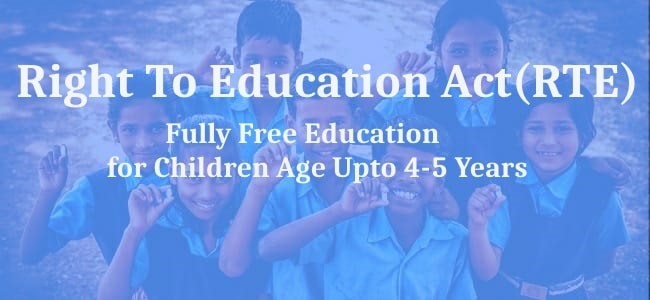
- It clarifies that ‘compulsory education’ means obligation of the appropriate government to provide free elementary education and ensure compulsory admission, attendance and completion of elementary education to every child in the six to fourteen age group.
- ‘Free’ means that no child shall be liable to pay any kind of fee or charges or expenses which may prevent him or her from pursuing and completing elementary education.
- It makes provisions for a non-admitted child to be admitted to an age appropriate class.
- It specifies the duties and responsibilities of appropriate Governments, local authority and parents in providing free and compulsory education, and sharing of financial and other responsibilities between the Central and State Governments.
- It lays down the norms and standards relating inter alia to Pupil Teacher Ratios (PTRs), buildings and infrastructure, school-working days, teacher-working hours.
- It provides for rational deployment of teachers by ensuring that the specified pupil teacher ratio is maintained for each school, rather than just as an average for the State or District or Block, thus ensuring that there is no urban-rural imbalance in teacher postings.
- It also provides for prohibition of deployment of teachers for non-educational work, other than decennial census, elections to local authority, state legislatures and parliament, and disaster relief.
- It provides for appointment of appropriately trained teachers, i.e. teachers with the requisite entry and academic qualifications.
- It provides for development of curriculum in consonance with the values enshrined in the Constitution.
- It would ensure the
- all-round development of the child,
- Building on the child’s knowledge,
- Potentiality and talent and
- Making the child free of fear, trauma and anxiety through a system of child centred learning.
- It prohibits
(a) physical punishment and mental harassment;
(b) screening procedures for admission of children;
(c) capitation fee;
(d) private tuition by teachers and
(e) running of schools without recognition.
How it will be implemented
- The government schools shall provide free education to all the children.
- The schools will be managed by School Management Committees (SMC).
- School Management Committees (SMCs) is comprising of local authority officials, teachers, parents and guardians.
- Parent and Guardians alone must constitute 75% in the SMC.
- RTE also mandates the inclusion of 50 per cent women and parents of children from disadvantaged groups in SMCs.
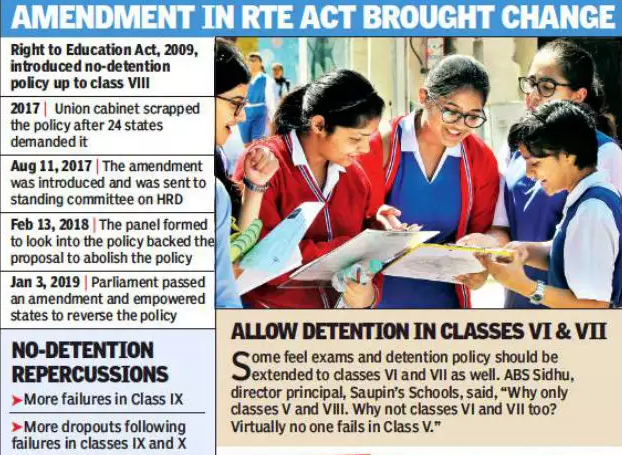
- It requires all private schools except the Minority institutions to reserve 25% of seats to children (to be reimbursed by the state as part of the public-private partnership plan).
- Kids are admitted in to private schools based on economic status or caste-based reservations.
- Kendriya Vidyalayas, Navodaya Vidyalayas, Sainik Schools, and unaided schools shall also come under this Act.
- No seats in this quota can be left vacant.
- There is provision that a school within 1 km walking distance for children in classes I to V and within 3 kms for those in classes VI to VIII. These schools are termed as neighbourhood schools.
- The government has the responsibility to undertake school mapping to determine the location of the school.
- These children will be treated on par with all the other children in the school and subsidized by the State at the rate of average per learner costs in the government schools (unless the per learner costs in the private school are lower).
- It also prohibits all unrecognised schools from practice, and makes provisions for no donation or capitation fees and no interview of the child or parent for admission.
- There is no direct (school fees) or indirect cost (uniforms, textbooks, mid-day meals, transportation) to be borne by the child or the parents to obtain elementary education.
- The only constraint is the distance between the school and home, rather than financial capacity.
- The Act also provides that no child shall be held back, expelled, or required to pass a board examination until the completion of elementary education.
- In other words, the Act prohibits detention of children till they complete elementary education (class 8).
- There is also a provision for special training of school drop-outs to bring them up to par with students of the same age.
- In other words, the first-time enrolled child is to be admitted to an age appropriate class.
- The Right to Education of persons with disabilities until 18 years of age is laid down under a separate legislation - the Persons with Disabilities Act.
- In April 2010 the central government agreed to sharing the funding for implementing the law in the ratio of 65 to 35 between the centre and the states, and a ratio of 90 to 10 for the north-eastern states.
- However, in mid-2010, the centre agreed to raise its share to 68%.
- The National Commission for Elementary Education shall be constituted to monitor all aspects of elementary education including quality.
- For the purpose of admission to elementary education, the age of a child shall be determined on the basis of the birth certificate issued in accordance with the Provisions of Births, Deaths and Marriages Registration Act 1856, or on the basis of such other document as may be prescribed.
- No child shall be denied admission in a school for lack of age proof.
- A child who completes elementary education shall be awarded a certificate.
- There should be one teacher for every 30 students for the class I to V and one teacher for every thirty-five students for class VI to VIII.
- Two trained teachers will be provided for every sixty students at the primary level.
- The number of teachers shall be based on the number of students rather than by grade.
- There should be one specialised teacher each for teaching (i) Science & Mathematics (ii) Social Sciences and (iii) Languages.
- A full-time Head Teacher is recommended for a school with more than 100 students.
- Classes I to V should have 200 working days & Classes VI to VIII 220 working days per academic year, with a 45-hour work week.
- All weather classroom for every teacher in the school, an office, a store room and a principal’s room is must for every school.
- The school has to ensure hygienic kitchen for midday meals, safe drinking water facility, and separate toilets for boys and girls along with proper fencing, playground and a library with relevant books and teaching aid.
- The National Commission for the Protection of Child Rights (NCPCR) has been designated as the agency to monitor provisions of the Right to Free and Compulsory Education (RTE) Act.
- The NCPCR shall review the safeguards for rights provided under this Act, investigate complaints and have the powers of a civil court in trying cases.
- States should constitute a State Commission for the Protection of Child Rights (SCPCR) or the Right to Education Protection Authority (REPA) within six months of 1 April, 2010.
Analysis
- However, there are no specific penalties if the authorities fail to provide the right to elementary education.
- Both the state government and the local authority have the duty to provide free and compulsory elementary education. Sharing of this duty may lead to neither government being held accountable.
- The Act provides for the right to schooling and physical infrastructure but does not guarantee that children learn.
- It exempts government schools from any consequences if they do not meet the specified norms.
- The Act legitimises the practice of multi-grade teaching.
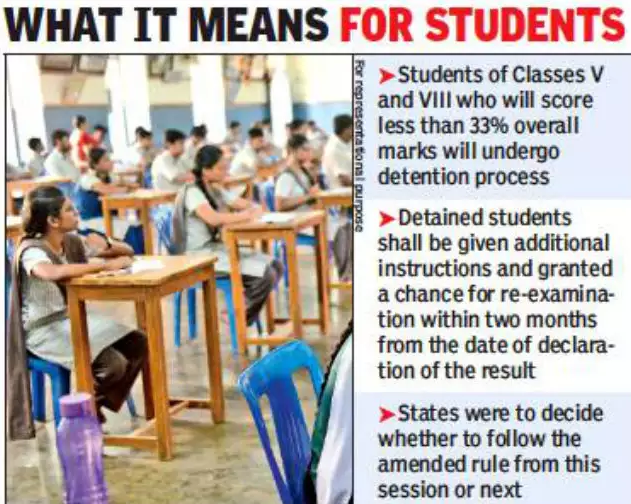
RTE Act 2019
- The Right of Children to Free and Compulsory Education (Amendment) Act, 2019 was passed by the Parliament on January 3, 2019.
- It received the assent of the President of India on January 10, 2019.
- The Act seeks to do away with the no-detention policy in schools.
- The Right to Education Act, 2009 prohibits detention of children till they complete elementary education i.e., class 8.
- The 2019 Act amends this provision to state that a regular examination will be held in class 5 and class 8 at the end of every academic year.
- If a child fails the exam, he will be given additional instruction, and take a re-examination.
- If a child fails in the re-examination, the relevant central or state government may decide to allow schools to detain the child.
- The TSR Subramanian committee for formulation of the National Policy on Education has also suggested that ‘no detention’ policy should be discontinued after Class V.
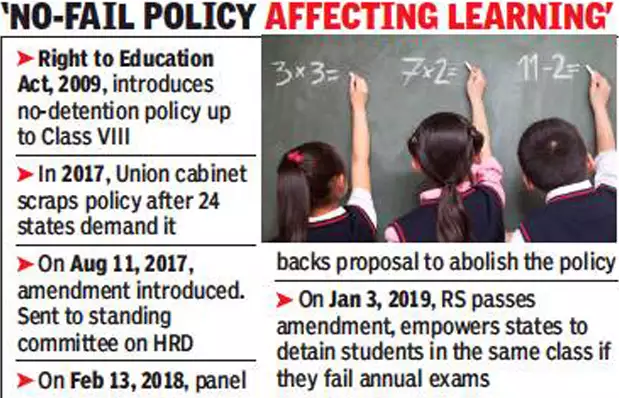
Conclusion
- It took India 62 years after Independence to guarantee school education as a fundamental right for its young children.
- The RTE Act must now focus on improving the quality of education. It must also be ensured that any further amendments to the Act are well thought out to avoid complexities in implementation.
- Most of the challenges facing the Act can be overcome by its next decadal anniversary.
ó ó ó ó ó ó ó ó ó ó
Leave a Reply
Your Comment is awaiting moderation.


